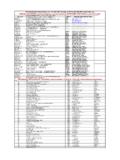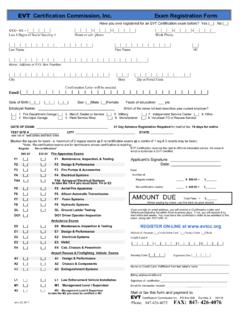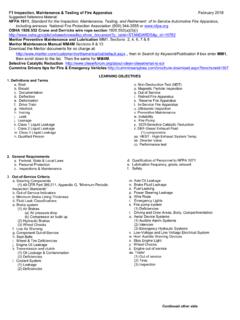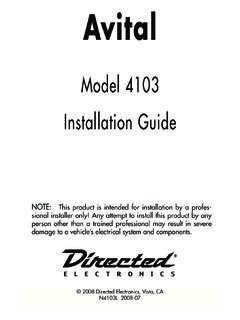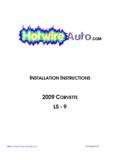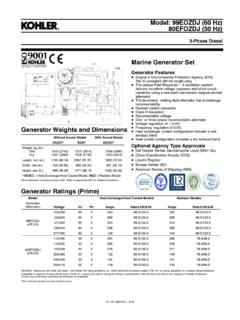Transcription of Any Fundamental Electrical Troubleshooting …
1 F-4 Electrical Systems February 2019aReference Materials: Note: This exam also contains many hands-on type questions you may not find in any reference material listed belowNFPA reference listed below - National Fire Protection Association, Quincy, MA, (800) 344-3555 or NFPA 1901, Standard for Automotive Fire Apparatus Chapter 13 NFPA 1911, Standard for the Inspection, Maintenance, Testing, and Retirement of In-Service Automotive Fire ApparatusChapters 3, 6, 9, 14, 20, 25 Any Heavy Truck Electrical Manual-- Suggestion listed Electrical Troubleshooting , by Dan Sullivan 800-227-1603 or online retailersAny emergency apparatus service and operator manual (OEM)
2 LEARNING OBJECTIVES FOR THE F-4 Principles of Electricity-Define or of electron flow(1)Causes of resistance in circuits(2)Definitions and terms(3)Current flow in parallel circuits(4)Current flow in series circuits(5) Controlling current (6) Spike suppressionb. Ohms Law as applied to Electrical circuits(1)Relationship of volt, amp, resistance(2)Calculating resistance in parallel circuits(3)Units of measure for Ohm s Law(4)Calculating resistance and voltage in series of electromagnetism(1)How an electromagnet is created(2)Uses of electromagnet(3)Straight conductor vs. coiled conductord. Electrical symbols and schematics(1)Switch & relay symbol & terminal identification(2)General circuit & symbols, ground, motors, Formulas as applied to Electrical circuits (1)Relationship of volts, amps, & watts(2)Calculating power, amp, and voltage types(1)Series & parallel(2)Combo series/parallel(3) Shielded Circuits2.
3 Basic Principles of Operation-Describe or identify:a. Function & application of Electrical components and accessories(1)relays & diodes(2)switches(3)solenoids(4)interloc ks(5)interface(6)inverter & convertors(7)load managers & sequencer(8)electronic throttles(9)ECM/ECUb. Function and application of electronic components(1)diodes(2)capacitors(3)resis tors(4)lighting-incandescent, halogen, ,& strobes(5)data buses(6)multiplexing(7) traffic preemption devicesc. System requirements and performance evaluation(1)voltage drop, current draw, resistanced. Evaluation of wire size, insulation, and circuit protection(1)Fuses and circuit breakers-types(2)insulation ratings(3)wire gauge sizee.
4 Proper wire repair procedures and proper routing techniques(1)Solder techniques(2)wire termination, terminal & crimping tool(3)wire loom ratings(4)corrosion protectionsf. Equipment and component protection (1)welding precautions(2)spike protections(3)static dischargeg. Function, operation, & testing of gauges & warning devices(1)ammeters, voltmeters(2)gauges(3)Temperature gauge(a) instrument voltage regulators(4) electric speedometers & Use of Diagnostic Equipment/Toolsa. Describe diagnostic equipment used to measure voltage,current, resistance & impedance(1)Interpretation of oscilloscopes(2)Proper diagnostic equipment/meter connections(a) Voltmeter(b) Ammeter(c) Ohmmeterb.
5 Evaluate quality and application of diagnostic equipment(1)Applications of DVOM(DMM)(2)Applications of load testers(3)Applications of analog meters(4) Diagnostic equipment usage(a) Testing diodes(5) Inductive ammeters(6) Meter Batteries-Describe or Identify:a. Battery construction and performance(1)Safety-jump starting(2) Components(a) spark arrester(3) Purpose-types-construction(a) lead-acid(4) Define a battery(5) Causes of battery failureb. How to evaluate battery requirements(1) Reserve capacity(2) (a) Battery cold cranking rating(3) BCI group identification(4) Operating temperature(5) Battery pack combinationsc. Proper battery maintenance procedures(1) Types of chargers(2) Charging rates(3) Battery maintenanced.
6 Proper battery testing procedures(1) Replacement(2) Load Testing(3) Conductivity testing(4) Define surface charge(5) Determine state of charge w/DMM Systems -- Understand the construction and operation of starting system componentsa. Describe starting system construction and operation(1) Circuit component(2) Mechanical components (a) Starter solenoid(3) Preventing starter motor over-speed(4) Field winding types(5) Pull in & hold in cranking system & component testing procedure(1) Wiring and connections(2) Mechanical components/drive pinions(3) Current draw(4) Slow cranking engine (a) Voltage drop(5) Starter activation proper repair procedures(1) Connections(2) Solenoid switch contact(3) Starter interlock system(4) Systems--Understand construction and operation of the charging system and componentsa.
7 Alternator construction and operation(1) Function of components(a) Alternator capacitor(b) Voltage regulator(2) Alternator output/operation(3) Alternator Design(4) Component recognition(a) Stator(5) Drive requirements(6) Noise suppressionb. Alternator & Regulator diagnosis and testing(1) Unit testing(2) Component testing(3) On vehicle/off vehicle testing(a) Undercharge/overcharge condition(4) Battery isolator/isolated systems(5) Mounting hardware(6) Regulator adjustment procedure(7) Belt tension and wrap(8) Maintenance Free vs. Low Maintenance batteries(a) charge voltagec. Proper repair procedures(1)Component failures(2) Replacement of regulators and remote rectifier(3) Alternator failuresd.
8 Evaluate charging system requirements(1) Load analysis(2) Cable size(3) Set output --Understand accepted practices used to diagnose and repair Electrical circuits. results(1) Interpretation of functional drawing reading (2) Circuit wiring/connection(3) Current drawb. Components(1) Relays/solenoids(2) Interlocks & Interfaces(3) Switches & proximity(4) Load managers(5) Sequencer(6) Proper ground connections(7) Terminals(8) Gaugesc. Tools and equipment(1) DVOM/DMM(2) Induction meters(3) load testsd. Diagnostic tests(1) Voltage drop8. NFPA 1911-Chapters 3, 6, 9, 14, 20, 25a. Low Voltage Electrical Systems(1) Inspection and Maintenance(a) Automatic Electrical load management systems (2) Performance Testing(a) Battery testing(b) Alternator testing(I) Parameters(II) Electrical load(c) Total continuous Electrical load test(I) Load Shedding(d) Solenoid and Relay Test(I) Voltage drop maximum(e) Conductivity Test(f) Starter wiring test(g) Regulator test(h) Voltage Drop Spec s(i) Lighting Tests(j) On Board Battery Charger/Conditioner Test(3) Out of Service Criteriab.
9 Line Voltage Electrical Systems(1) Inspection and Maintenance (2) Performance Testing (3) Out of Service Criteria(4) Power Source Testing(a) Receptacle wiring
